The significance of education cannot be overstated in the context of fostering employee learning and development (L&D) and ensuring customer retention.
However, issues persist across many organizations wherein their training and development strategies fall short of delivering results, exhibiting a notable lack of effectiveness in empowering employees and retaining customers.
According to data from Forbes, 59% of employees report a lack of workplace training, relying mostly on self-taught skills. This highlights a notable gap in businesses’ training initiatives, representing missed opportunities for building a learning culture consisting of a more skilled workforce.
Dependence on self-learning burdens individual employees and signifies a systemic failure in harnessing the full potential of workplace training. The data emphasizes the need for organizations to strengthen their training frameworks.
The bottom line is that inadequate investment in structured training deprives employees of skill enhancement and jeopardizes workforce competency and adaptability.
Enter training manuals, a vital navigational tool for organizational development. These resources bridge knowledge gaps, empower employees with essential skills, and ensure a streamlined learning experience.
This article explores the critical role of training manuals as a solution to pervasive organizational training and development issues and shows you how to create effective and impactful manuals that enhance learning experiences and drive success in the modern workplace.
What is a Training Manual?
A training manual is a detailed document that facilitates the teaching and learning of a specific skill, procedure, or set of instructions.
It is a structured resource offering step-by-step guidance and pertinent information for individuals undergoing training or user onboarding processes. Training manuals ensure consistency in training, enhance comprehension, and provide a reference tool for employees.
Training manuals commonly feature written instructions, visual aids, diagrams, examples, and exercises to facilitate effective knowledge and skill acquisition. The format of training manuals, whether in print or digital, varies based on the training context and requirements.
Acting as digital training manuals, digital adoption platforms (DAPs) guide users through software applications by offering real-time contextual assistance, interactive tutorials, and step-by-step instructions, enhancing the user experience and promoting efficient utilization of the digital environment.
Why are Training Manuals Important?
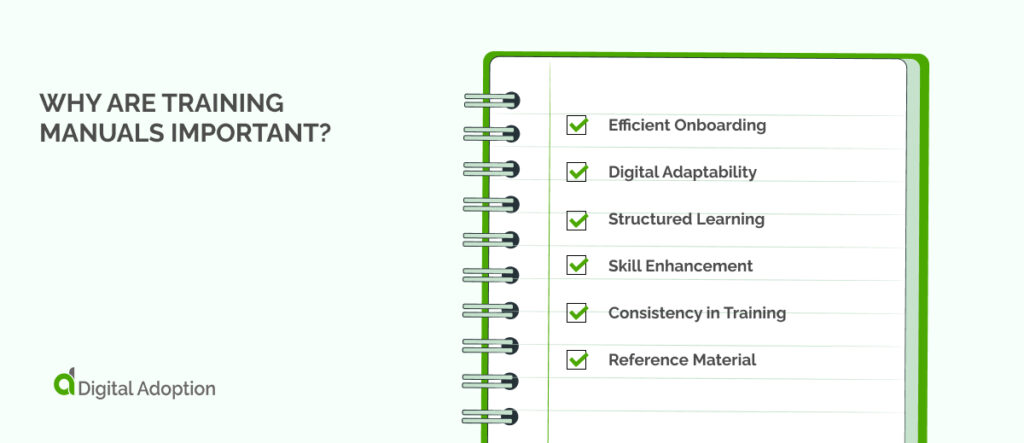
Picture training manuals as expert guides, lighting the way for employees through the intricacies of their roles, much like a user-friendly app providing step-by-step directions for seamless navigation.
Imagine a tech team armed with a top-notch training manual, mastering new software updates, seamlessly aligning their efforts, and driving the company towards innovation—all made possible by the strategic guidance encapsulated within the manual’s pages.
Let’s take a closer look at why training manuals are important:
Efficient Onboarding
Training manuals expedite the onboarding processes for new employees. They ensure a rapid assimilation of essential information, facilitating a swift integration into the dynamic workflow of contemporary workplaces.
Digital Adaptability
Training manuals demonstrate adaptability by seamlessly transitioning between print and digital formats. This versatility enables their effective application in diverse learning environments within the modern workplace.
Structured Learning
Amidst the rapid pace of modern business operations, training manuals provide a structured and systematic approach to learning. They guide individuals through up-to-date processes and methodologies, ensuring relevance and strategic alignment.
Skill Enhancement
Modern training manuals go beyond traditional methods, incorporating advanced techniques such as interactive exercises, real-world examples, and visual aids. This approach caters to the dynamic skill requirements prevalent in today’s workplace, actively contributing to skill enhancement.
Consistency in Training
With a focus on standardized training delivery, manuals ensure consistency across various departments within a modern business. This uniformity fosters a cohesive work environment, promoting collaboration and streamlined operations.
Reference Material
Training manuals serve as accessible and comprehensive reference materials. Employees can autonomously revisit information, troubleshoot issues, and reinforce their knowledge, contributing to continuous learning and development within the organization.
What are the Different Types of Training Manuals?
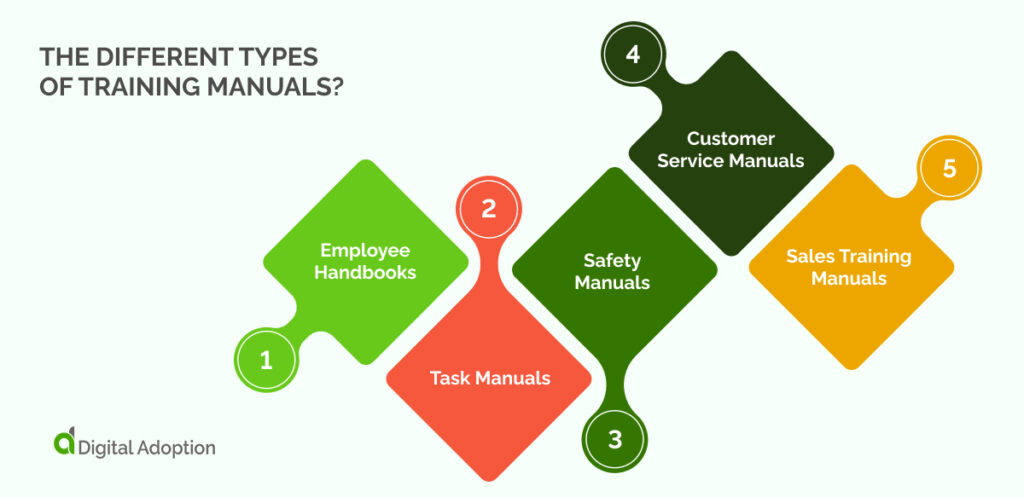
Understanding the diverse types of training manuals and their intended uses helps businesses craft bespoke training that targets the individual needs of employees.
Let’s take a closer look at the different types of training manuals:
Employee Handbooks
Employee handbooks outline an organization’s policies, procedures, and guidelines. They cover workplace conduct, attendance, benefits, and organizational culture. These manuals serve as a crucial reference for employees to navigate the company’s expectations and standards, ensuring a unified and informed workforce.
Task Manuals
Task manuals provide detailed instructions and procedures for specific job-related tasks. They break down complex processes into step-by-step guides, facilitating employee understanding and proficiency in executing their responsibilities. Task manuals contribute to operational efficiency by offering a structured approach to various organizational job functions.
Safety Manuals
Safety manuals are designed to establish and communicate safety protocols and procedures within a workplace. They encompass information on emergency response plans, hazard identification, and compliance with occupational health and safety regulations. These manuals are essential for promoting a secure work environment and preventing accidents or incidents.
Customer Service Manuals
Customer service manuals equip employees with the necessary skills and knowledge to deliver exceptional service. They cover effective communication strategies, problem-solving techniques, and guidelines for building positive customer relationships. These manuals promote a customer-centric approach across the organization, enhancing overall customer satisfaction.
Sales Training Manuals
Sales training manuals provide a comprehensive guide for sales teams, offering insights into sales techniques, product knowledge, and customer engagement strategies. They assist sales professionals in understanding the features and benefits of products or services, mastering effective sales methodologies, and adapting to the evolving sales economy.
How to Create a Training Manual
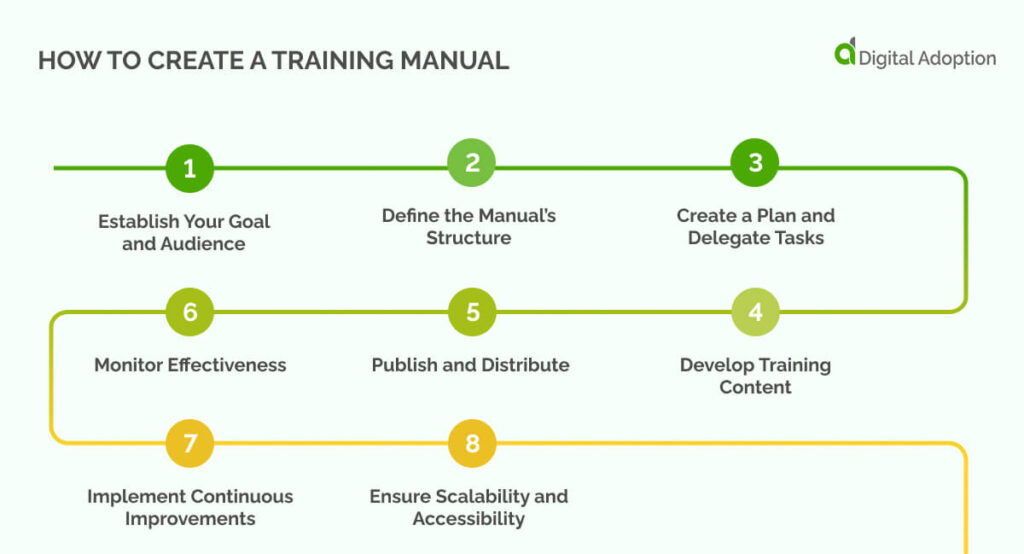
Off-the-shelf training solutions no longer cut it.
The paradigm has shifted towards bespoke and personalized training manuals that resonate with the unique needs of your organization. Imagine a training resource tailored to your specific requirements, aligning seamlessly with your company culture and objectives.
But why stop there?
Training manuals can even evolve into dynamic digital entities and integrate into digital adoption platforms (DAPs). This is just one example, but the ongoing technological advancements suggest a future where traditional instructional materials seamlessly transition into interactive, AI-driven learning experiences.
With that in mind, let’s explore how to build a bespoke training manual:
- Establish Your Goal and Audience
The training manual crafting process involves a strategic foundation, beginning with a meticulous outlining of objectives and a thorough identification of the nuanced demographics of the audience. Drafting clear learning outcomes ensures these objectives are the guiding framework for content development, guaranteeing a purposeful and efficient training experience.
Understanding the audience’s diverse backgrounds, prior knowledge, and learning preferences is paramount. This nuanced approach tailors the manual to resonate personally, enhancing engagement and relevance.
Aligning the manual with overarching business goals is equally crucial. This ensures that the training objectives contribute directly to broader organizational success, reinforcing the company’s strategic direction.
Well-defined objectives and a deep understanding of the audience lay the groundwork for an effective training manual, promoting a well-equipped and informed workforce. As the manual crafting process unfolds, these considerations act as a compass, guiding the creation of content that not only instructs but also aligns with the unique needs of the learners, contributing to individual growth and long-term success.
Digitizing this step:
Utilize analytics tools to gather data on user interactions with the training manual. Digital adoption platforms (DAPs) can help track user engagement and identify areas where learners might struggle, facilitating targeted improvements. Understanding the specific needs of users enables the integration of features that enhance the digital learning experience, ensuring a seamless transition to modern training methodologies.
- Define the Manual’s Structure
Precision is key in designing the manual structure, similar to a surgical procedure segregating content into meticulously crafted modules. This deliberate approach facilitates a logical progression, ensuring coherence throughout the learning journey.
Cognitive load is minimized by breaking down the content into modular components, offering learners a streamlined and digestible experience. This strategic design optimizes comprehension and enhances retention, as users can easily navigate the material.
The manual’s structure evolves into a strategic tool, pivotal in augmenting overall effectiveness. It transforms the learning experience into a user-friendly and organized process where information is well-ordered. This meticulous organization ensures learners can grasp concepts seamlessly, fostering a more engaging and impactful educational experience.
Digitizing this step:
Digital transformation benefits from a well-structured manual that aligns with the user journey. Consider integrating interactive features within the digital format, such as clickable sections in a DAP or hyperlinks in a digital document, fostering a more engaging and intuitive learning experience. This approach contributes to smoother digital adoption, aligning with users’ evolving expectations in a technologically advanced business environment.
- Create a Plan and Delegate Tasks
In crafting a training manual, it is crucial to elaborate on a comprehensive plan that outlines every step of the process. The key to success lies in systematically delegating tasks among proficient contributors who bring diverse skills to the table. Careful consideration of individual skill sets is paramount when assigning responsibilities, ensuring that each contributor is tasked with roles that align with their expertise. This judicious assignment fosters a streamlined development process, maximizing efficiency and minimizing redundancies.
A well-executed plan and strategic task delegation form the bedrock for a collaborative and agile approach to crafting a training manual. The synergy among team members, each contributing their unique strengths, creates a harmonious working environment. This collaborative spirit enhances creativity, problem-solving, and the overall quality of the manual.
An agile approach allows for adaptability, enabling the team to respond effectively to unforeseen challenges and changes in the project landscape. Ultimately, a thoughtfully devised plan and the systematic delegation of tasks pave the way for a cohesive and successful training manual creation process.
Digitizing this step:
Leverage digital communication tools for collaboration and task delegation, streamlining the gathering of insights from subject matter experts. Involving various perspectives digitally ensures that the training content addresses diverse user needs. Incorporating feedback mechanisms within digital platforms to continuously adapt the manual to changing requirements supports ongoing digital transformation efforts.
- Develop Training Content
When crafting a training manual, elaborate on a comprehensive plan that outlines every step of the process. The key to success lies in systematically delegating tasks among proficient contributors who bring diverse skills to the table.
Nurture a comprehensive training content strategy that goes beyond textual information by carefully considering individual skill sets, using a range of multimedia elements. Infusing diverse learning modalities, such as videos, interactive simulations, and graphics, caters to the varied preferences of the audience, fortifying the absorption and application of knowledge. A multifaceted approach transforms the training material into a dynamic and engaging learning experience, capturing the audience’s attention and maintaining their interest throughout the educational journey.
Incorporating multimedia elements transforms the training content into more than just words on a page; it evolves into a visual, auditory, and interactive feast that caters to different learning styles. This immersive experience reinforces understanding and enhances the retention of information, ensuring that learners can apply the acquired knowledge effectively in real-world scenarios.
Digitizing this step:
Tailor the content creation process to the specific type of training manual using specialized digital tools. For in-app training, consider digital adoption platforms that provide real-time guidance within the application interface, enhancing user understanding and minimizing time-to-value. Integrating multimedia elements, such as videos and interactive content, aligns with modern expectations for engaging digital learning experiences, facilitating smoother digital adoption and transformation.
- Publish and Distribute
Disseminate your manual strategically, using digital platforms to ensure seamless accessibility. Embrace contemporary distribution channels that enable swift and widespread availability, catering to the dynamic needs of the targeted audience. This phase marks a transformative shift, turning the manual from a static document into a dynamic resource accessible across multiple platforms.
Utilizing digital platforms allows the manual to reach a broader audience, breaking down geographical barriers and accommodating diverse learning preferences. Embracing contemporary distribution channels, such as online learning portals, webinars, or mobile applications, enhances the manual’s reach, making it readily available to individuals with varying schedules and technological preferences. This adaptability not only increases accessibility but also ensures that the manual remains relevant in the rapidly evolving digital landscape.
Digitizing this step:
Optimize the distribution process using digital platforms like knowledge bases or content management systems. Employ version control features to ensure that users access the latest information. Consider platforms that enable contextual guidance directly within applications, minimizing the need for users to switch between different tools and environments. This approach enhances accessibility and expedites the integration of digital processes.
- Monitor Effectiveness
Evaluate the effectiveness of the manual by implementing systematic monitoring mechanisms. Use analytics tools to quantitatively assess learner progress and engagement, providing insightful data to identify specific areas for enhancement.
A data-driven approach serves as a valuable feedback loop, enabling targeted improvements that maximize the impact of the training material. By closely analyzing learner interactions and performance metrics, organizations gain a nuanced understanding of how well the manual aligns with evolving business objectives.
Monitoring mechanisms track the completion rates and comprehension levels and highlight engagement patterns and areas of potential improvement. An evaluation like this allows for a proactive approach to refining the training content, ensuring its continued relevance and effectiveness.
Digitizing this step:
Exploit analytics tools provided by digital platforms to monitor the effectiveness of the training manual. Understand user engagement and completion rates and identify potential areas for improvement. Real-time analytics can offer insights into user behaviors, helping organizations proactively address challenges. Incorporate post-training surveys within digital platforms to gather user feedback, fostering a culture of continuous improvement.
- Implement Continuous Improvements
Foster a continuous improvement culture by implementing protocols prioritizing refinement over time. Actively solicit feedback from users and stakeholders, nurturing an iterative process that consistently enhances content and delivery mechanisms. This proactive approach to evolution is pivotal in ensuring the training manual remains relevant and effective amidst changing business dynamics.
Engaging in a continuous feedback loop allows for real-time insights into the user experience, shedding light on areas that require enhancement. This iterative process addresses immediate concerns and lays the groundwork for long-term improvements. Stakeholder input is a valuable guide, providing perspectives from various vantage points, including end-users and those with a strategic business focus.
This commitment to ongoing improvement creates a dynamic feedback loop, cultivating adaptability and resilience within the training manual.
Digitizing this step:
Establish a feedback loop within the digital training ecosystem to facilitate ongoing enhancements. Leverage real-time data from analytics tools to identify gaps and areas that require refinement. Agile methodologies can be applied to iteratively improve the training manual based on evolving user needs and technological advancements. Implement a collaborative platform that allows stakeholders to contribute suggestions, ensuring a dynamic and adaptive approach to digital learning.
- Ensure Scalability and Accessibility
Strengthen the scalability and accessibility of the manual by embracing agile technologies. Enable seamless adaptation to evolving organizational structures and technological landscapes, ensuring the manual’s accessibility across a spectrum of devices and user profiles. This commitment to technological agility enhances the immediate utility of the manual and future-proofs it, enabling continual evolution alongside the dynamic business landscape.
Agile technologies empower the manual to transcend constraints, adapting effortlessly to changes in organizational hierarchies and technological advancements. This adaptability ensures users can access the manual on diverse devices, accommodating varied preferences and work environments. Future-proofing the manual through technical agility transforms it into a dynamic and enduring resource, remaining relevant and valuable across different contexts.
Digitizing this step:
Ensure the training manual is scalable and accessible across various devices and platforms. Utilize responsive design principles to adapt content for different screen sizes, making the digital learning experience seamless for users on desktops, tablets, and smartphones. Implement cloud-based solutions for storage and accessibility, enabling users to access training materials anytime, anywhere. This ensures that the training manual remains relevant and effective as the organization scales its digital initiatives and accommodates the diverse needs of a dispersed workforce.
What are the Benefits of Training Manuals?
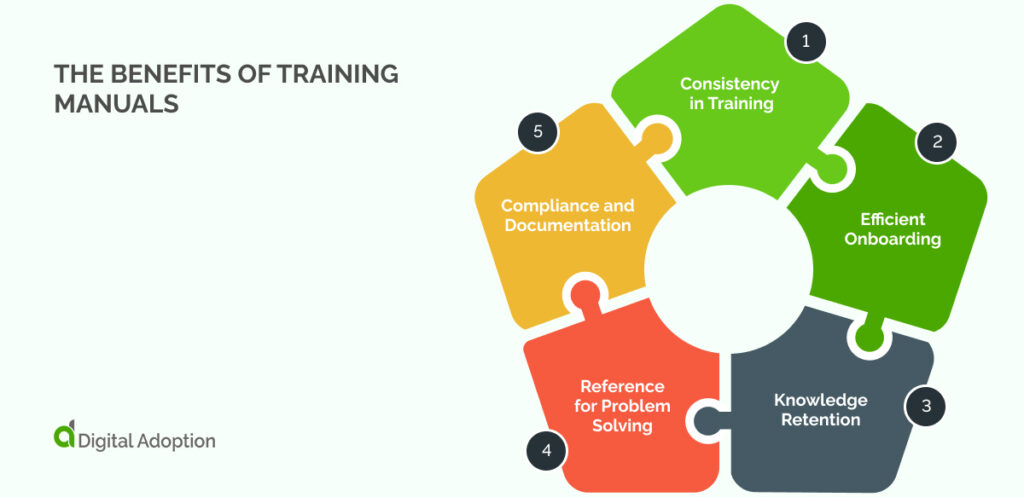
Training manuals streamline onboarding, foster consistency, and serve as invaluable references, ensuring efficient knowledge transfer, problem-solving, and regulatory compliance in modern business contexts.
Let’s explore the benefits in more detail:
- Consistency in Training: Training manuals ensure consistent information delivery across all employees. This uniformity helps maintain standardized procedures and practices, fostering a cohesive work environment and reducing the risk of errors.
- Efficient Onboarding: Training manuals serve as valuable resources during the onboarding process. New employees can reference these manuals to quickly grasp essential information, accelerating the integration into their roles and minimizing the time needed for training sessions.
- Knowledge Retention: With documented information readily available, training manuals support long-term knowledge retention. Employees can refer to the manual as a refresher, reinforcing their understanding of key concepts and procedures over time.
- Reference for Problem Solving: Manuals act as go-to references for problem-solving. Employees can consult the manual when faced with challenges, ensuring access to accurate and standardized solutions, promoting self-sufficiency, and reducing dependency on additional support.
- Compliance and Documentation: In regulated industries, training manuals play a crucial role in ensuring compliance with industry standards and regulations. They serve as documented proof that employees have received the necessary training, providing a foundation for legal and regulatory compliance within the business.
Training Manual Use Cases
Recognizing the nuanced applications of training manuals is crucial, as they act as customized guides across a spectrum of scenarios.
These encompass employee onboarding, customer engagement, self-service support, software introductions, compliance adherence, and sales proficiency.
Let’s explore the most popular training manual use cases in more detail:
Employee Onboarding
- Cultural Integration: Training manuals are pivotal in introducing new hires to the organizational culture. They outline company values, norms, and expectations, facilitating a seamless integration process for employees into the workplace community.
- Operational Procedures: These manuals detail day-to-day operational procedures, providing a comprehensive overview of internal processes, policies, and guidelines. This equips new employees with the necessary knowledge to navigate their roles effectively from the outset.
- Resource Navigation: Employee onboarding manuals serve as a guide for accessing various resources within the organization, including contacts, tools, and support channels. This ensures newcomers can efficiently connect with the right individuals and leverage available resources.
Customer Onboarding
- Product Familiarization: Training manuals for customer onboarding focus on familiarizing clients with a company’s products or services. They provide insights into product features, functionalities, and usage, ensuring customers can make the most of their purchases from the very beginning.
- Guidance for Effective Use: These manuals guide customers on the initial steps of using a product or service. From setup instructions to best practices, they empower customers to maximize the value of their investment and enhance their overall experience.
- Troubleshooting Assistance: Customer onboarding manuals often include troubleshooting tips to help users address common issues independently. This fosters a sense of self-sufficiency among customers and reduces the need for extensive customer support.
Self-Service Customer Support
- FAQs and Troubleshooting: Manuals designed for self-service support contain detailed FAQs and troubleshooting guides. These resources empower customers to find solutions to common problems autonomously, alleviating the need for direct support and enhancing customer satisfaction.
- Clear Communication Channels: They often provide information on how customers can effectively communicate with the support team if needed. This ensures that users are aware of the available support channels and can navigate them with ease.
- User Empowerment: By offering self-service solutions, these manuals empower customers to resolve issues swiftly, contributing to a positive customer experience and freeing up support teams to address more complex inquiries.
New Software Rollouts
- Installation Guidance: Manuals for new software rollouts offer step-by-step instructions for installation, ensuring a smooth onboarding process for employees adapting to updated technologies.
- Feature Highlight: They provide overviews of new features and functionalities, helping users quickly grasp the software’s capabilities. This accelerates the learning curve and promotes efficient utilization of the software.
- Security Protocols: Inclusion of security protocols and updates ensures that users are aware of and adhere to the latest security measures, safeguarding the organization against potential risks.
Compliance Training
- Legal and Ethical Guidelines: Manuals for compliance training detail legal and ethical guidelines, providing employees with a clear understanding of the regulatory landscape and ethical standards applicable to their roles.
- Interactive Learning: These manuals often incorporate interactive elements such as scenarios, case studies, and assessments, fostering engagement and reinforcing employees’ comprehension of compliance requirements.
- Reporting Procedures: Clear reporting procedures for non-compliance are outlined, ensuring that employees understand the steps to take in the event of potential violations. This contributes to a culture of accountability within the organization.
Sales Training
- Product Knowledge: Sales training manuals are instrumental in equipping sales teams with in-depth product knowledge. They provide comprehensive details about products and services, enabling sales representatives to communicate effectively with potential clients.
- Sales Strategies: These manuals often include sales techniques, methodologies, and best practices. They guide sales professionals to enhance their communication skills, objection handling, and effectiveness in closing deals.
- Market Insight: Manuals for sales training may include competitor analysis and target audience profiles, empowering sales teams with valuable insights to adapt to changing market dynamics and tailor their approaches accordingly.
Training Manuals: Relics To Dynamic Assets
Training manuals aren’t relics but the linchpins of organizational progress.
From digitization to Digital Adoption Platforms (DAPs), these guides aren’t just keeping pace—they’re the foundation for seamless transitions, skill upgrades, and perpetual relevance.
Training manuals aren’t fading; they’re evolving. Embrace the manual, master the digital dance, and witness your business adapt and thrive in the techno-rhythm of progress.
As businesses continue to navigate the digital landscape post-COVID, training manuals stand tall as the unsung heroes, transforming into strategic tools for encouraging continuous learning and adaptation.

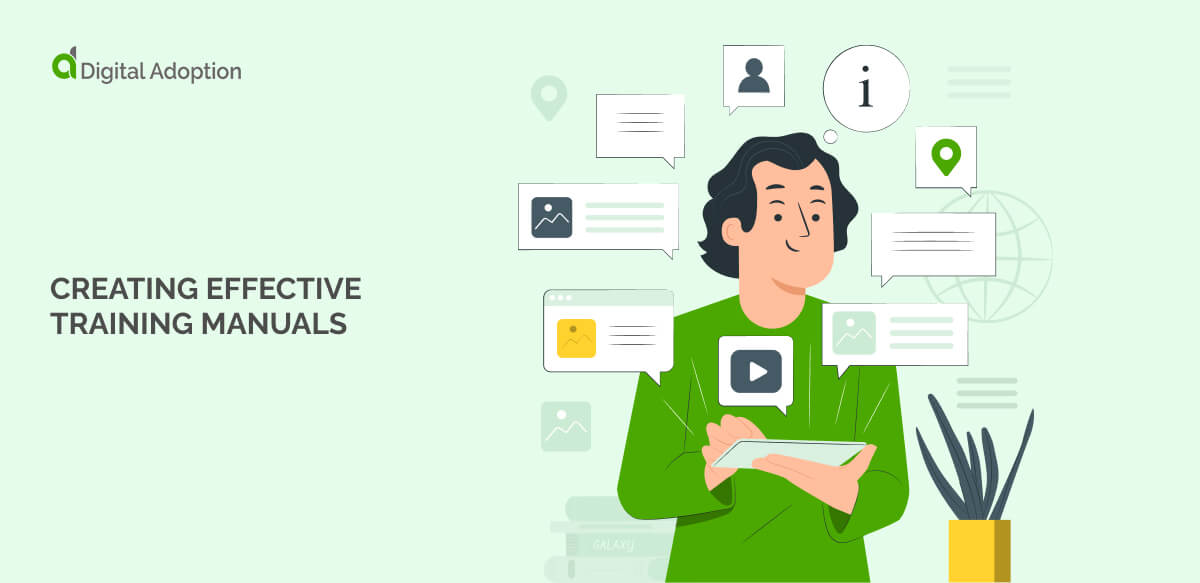



![4 Best AI Chatbots for eCommerce [2025]](https://www.digital-adoption.com/wp-content/uploads/2025/03/4-Best-AI-Chatbots-for-eCommerce-2025-img-300x146.jpg)


![13 Digital Transformation Enablers [2025]](https://www.digital-adoption.com/wp-content/uploads/2025/02/13-Digital-Transformation-Enablers-2025-img-300x146.jpg)



![4 Best AI Chatbots for eCommerce [2025]](https://www.digital-adoption.com/wp-content/uploads/2025/03/4-Best-AI-Chatbots-for-eCommerce-2025-img.jpg)
